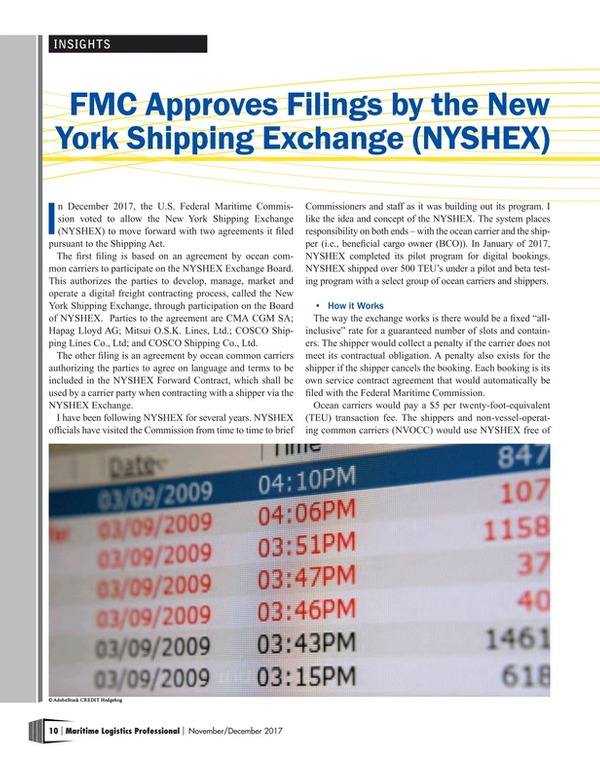
FMC Approves Filings by the New York Shipping Exchange
By William P. Doyle
In December 2017, the U.S. Federal Maritime Commission voted to allow the New York Shipping Exchange (NYSHEX) to move forward with two agreements it filed pursuant to the Shipping Act.
The first filing is based on an agreement by ocean common carriers to participate on the NYSHEX Exchange Board. This authorizes the parties to develop, manage, market and operate a digital freight contracting process, called the New York Shipping Exchange, through participation on the Board of NYSHEX. Parties to the agreement are CMA CGM SA; Hapag Lloyd AG; Mitsui O.S.K. Lines, Ltd.; COSCO Shipping Lines Co., Ltd; and COSCO Shipping Co., Ltd.
The other filing is an agreement by ocean common carriers authorizing the parties to agree on language and terms to be included in the NYSHEX Forward Contract, which shall be used by a carrier party when contracting with a shipper via the NYSHEX Exchange.
I have been following NYSHEX for several years. NYSHEX officials have visited the Commission from time to time to brief Commissioners and staff as it was building out its program. I like the idea and concept of the NYSHEX. The system places responsibility on both ends – with the ocean carrier and the shipper (i.e., beneficial cargo owner (BCO)). In January of 2017, NYSHEX completed its pilot program for digital bookings. NYSHEX shipped over 500 TEU’s under a pilot and beta testing program with a select group of ocean carriers and shippers.
How it Works
The way the exchange works is there would be a fixed “all-inclusive” rate for a guaranteed number of slots and containers. The shipper would collect a penalty if the carrier does not meet its contractual obligation. A penalty also exists for the shipper if the shipper cancels the booking. Each booking is its own service contract agreement that would automatically be filed with the Federal Maritime Commission.
Ocean carriers would pay a $5 per twenty-foot-equivalent (TEU) transaction fee. The shippers and non-vessel-operating common carriers (NVOCC) would use NYSHEX free of charge but the shippers and NVOCCs must be pre-approved with NYSHEX in order to participate.
In a nutshell, the NYSHEX platform is designed to help shippers make reservations and to reduce the uncertainty to carriers as a result of shippers failing to deliver the volume of containers that they had previously committed to send. Additionally, the carriers are held responsible to the shippers when the carriers do not load the containers as previously agreed and instead leave containers on the docks.
Shippers can book container slots on ships through an electronic portal. The portal is monitored by NYSHEX to determine whether the booking is fulfilled by shipper and carrier. The carriers and shippers negotiate and execute their own contracts. The rules are clear: If either party fails to fulfill its obligation, the shipper or carrier, depending on who is at fault, would forfeit between 30 to 40 percent of the agreed shipping cost. This would be an automatically generated penalty through the NYSHEX exchange eliminating the need for either side to chase the other for the default payment.
Looking Ahead
The Commission’s approval enables the carriers to take two rotating seats set aside for carrier representatives on the nine-member governing board. Importantly, two other seats on the board will be filled by shippers. These seats would be filled by either BCOs or NVOCCs.
The Commission will monitor the NYSHEX agreement moving forward nonetheless. The FMC will need to monitor “forward exits” where a shipper obtains a profit on the resale of space. The reason for this concern is that the shipper could perhaps manipulate the market by increasing freight rates. The Commission, will also monitor the Board’s ability to revise any aspect of the operation of NYSHEX including the forward contract, the trading rules, and membership requirements; for example, changes made to NYSHEX’s legal and compliance protocols.
The Commission conducted a review of filed agreements under 6(g) of the Shipping Act. This entails determining (a.) if the agreement results in a significant reduction in competition (b.) whether it is likely to produce an unreasonable reduction in transportation service, or (c.) an unreasonable increase in transportation cost. The answer is no to all questions; therefore I voted to allow the agreements to move forward.
NYSHEX is an early entrant to the concept of digitalizing the maritime transportation and logistics chain. There are start-ups attempting to form every day. NYSHEX has been at it since around 2012, building its platform and digital portal, running beta tests and pilot programs. It appears to be a platform that can be used effectively and be a useful, additional tool for the greater supply chain.
The Author
William P. Doyle is a Commissioner with the U.S. Federal Maritime Commission. Doyle was named in December as The Dredging Contactors of America’s new Executive Director and Chief Executive Officer (CEO). He is expected to assume that post in January. The thoughts and comments he expresses here are his own and should not be construed to represent the position of the Commission or his fellow Commissioners.
(As published in the November/December 2017 edition of Maritime Logistics Professional)
Read FMC Approves Filings by the New York Shipping Exchange in Pdf, Flash or Html5 edition of Nov/Dec 2017 Maritime Logistics Professional
Other stories from Nov/Dec 2017 issue
Content
- FMC Approves Filings by the New York Shipping Exchange page: 10
- Data Integration is Powering the Future of Shipping page: 16
- Domestic Maritime Policy: It's Not Business as Usual page: 19
- Green Shipping: Cargo Carriers Clutch at Compliance page: 42
- Cargo Security Goes High Tech page: 50
- A Familiar Name Tackles the Waterfront’s Changing Challenges page: 56
- Unlocking New LNG Transfer Possibilities page: 60


